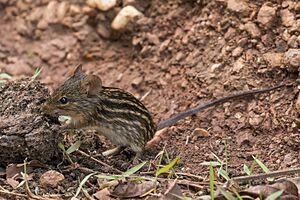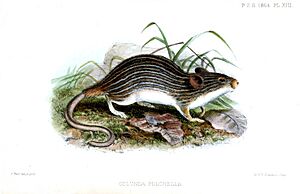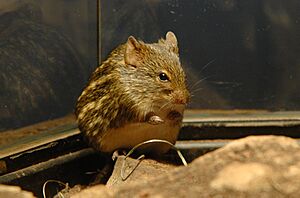Typical striped grass mouse facts for kids
Quick facts for kids Typical striped grass mouse |
|
|---|---|
 |
|
| Kakamega Forest, Kenya | |
| Conservation status | |
| Scientific classification | |
| Genus: |
Lemniscomys
|
| Species: |
striatus
|
| Synonyms | |
|
Mus striatus Linnaeus, 1758 |
|
The typical striped grass mouse (Lemniscomys striatus) is a small rodent that lives in parts of Africa. It belongs to the Muridae family, which includes many types of mice and rats. These little creatures are known for their distinctive striped coats.
Contents
Meet the Striped Grass Mouse
The typical striped grass mouse is part of a group of very similar species. There are about eleven different kinds of striped grass mice in total. Among them, the Lemniscomys barbarus and Lemniscomys striatus are the ones you might most often see if they are kept as pets.
Different Types of Striped Grass Mice
The Lemniscomys striatus species itself has six main types, called subspecies. They are found in different parts of Africa:
- L. s. striatus: Found in countries like Guinea Bissau, Guinea, Mali, Burkina Faso, Sierra Leone, Liberia, Ivory Coast, Ghana, Togo, Benin, Nigeria, Cameroon, Central African Republic, and the DRCongo.
- L. s. ardens (Thomas, 1910): Lives in central Kenya and southern Tanzania.
- L. s. dieterleni (Van der Straeten, 1976): Found in the eastern DRCongo.
- L. s. luluae (Matschie, 1926): Lives in Angola and the southern DRCongo.
- L. s. massaicus (Pagenstecher, 1885): Found in South Sudan, Uganda, Tanzania, Ruanda, Burundi, Zambia, and southeastern DRCongo.
- L. s. wroughtoni (Thomas, 1910): Lives in central and western Ethiopia.
What Does a Striped Grass Mouse Look Like?
The typical striped grass mouse is a small rodent. Its head and body together measure between 93 and 142 millimeters (about 3.6 to 5.6 inches). Its tail is usually a bit longer, ranging from 92 to 155 millimeters (about 3.6 to 6.1 inches).
These mice weigh up to 68 grams (about 2.4 ounces). The average adult mouse weighs around 42.3 grams.
Appearance Details
The back of the mouse is a blackish-brown color. It has pale stripes running down its back, all the way to the base of its tail. On each side of its body, you can see rows of small, pale spots.
The belly of the mouse is whitish. Its chest and lower belly might have yellowish hints. Its feet are brownish. The tail is darker on top and lighter underneath.
Life Cycle and Reproduction
The female typical striped grass mouse can start having babies when she is about 168 days old. After mating, the mother carries her babies for about 25 days. On average, a mother mouse will have about 4 or 5 babies in each litter.
Lifespan
These mice usually have a short life. In the wild, they often do not live much longer than their first breeding season. However, if they are kept in a safe environment, like a zoo or as a pet, they can live longer. The oldest typical striped grass mouse ever recorded lived for 4.8 years.
Where Do They Live?
This species is originally from Central and Western Africa. You can find them in many countries across the continent. These include Guinea, Sierra Leone, Ghana, Burkina Faso, Ethiopia, Angola, Kenya, Uganda, Rwanda, DRCongo, Tanzania, Zambia, and Malawi.
What Kind of Places Do They Like?
Typical striped grass mice prefer to live in open areas. They are often found in places where forests have been cleared. They also live in grasslands, areas with new forests growing (called secondary forests), and savannas. They can be found in these habitats up to 1,700 meters (about 5,577 feet) above sea level.




